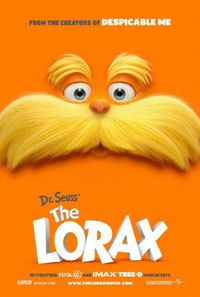 THE LORAX
THE LORAX(PG)
*** (out of 5)
March 2, 2012
STARRING
Danny DeVito as THE LORAX
Ed Helms as THE ONCE-LER
Zac Efron as TED
Taylor Swift as AUDREY
Betty White as GRAMMY NORMA
Rob Riggle as MR. O’HARE
Directed by: Chris Renaud and Kyle Balda
BY KEVIN CARR
Listen to Kevin’s radio review…
Did you know that there have been only four movies – including “The Lorax” – made from Dr. Seuss source material. Oh, there have been TV specials and sequel cartoons by the bundle, but only four feature-length films. And there’s a good reason for that (which I’ll expound upon later).
After the exceedingly dreadful “How the Grinch Stole Christmas” and the even worse “The Cat in the Hat,” Hollywood abandoned the live-action realm and made the film “Horton Hears a Who” as a CGI animated feature. And while “Horton Hears a Who” was charming and wonderful for many different reasons, the CGI animation allowed a full realization of the Seussical universe to be had.
What ranged from creepy to downright ugly in the live-action films (and if you don’t believe me, look at the “Things” from “The Cat in the Hat” or the entirety of the Whos in “How the Grinch Stole Christmas”) works in CGI. Dr. Seuss’ impossible architecture and physics can work in a cartoon while it is just uncomfortable in live-action.
It’s this that actually saves “The Lorax.” Were this a live-action movie, it would be as enjoyable as watching your parents make out. But the freedom of CGI allows a faithful image adaptation of the characters and the world they inhabit. Plus, the medium is perfect for the brilliant, hyperreal colors of the Lorax’s forest and the plasticized city of Thneedville. It is the visual aesthetic of “The Lorax” that helps the viewer forgive its major (though not insurmountable) faux pas.
The film is an adaptation of the 1971 Dr. Seuss picture book of the same name. Expanding considerably on the backstory of the characters, “The Lorax” follows a boy who travels beyond the outskirts of Thneedville to discover a wasteland that used to be a beautiful forest of Truffula trees. There, he finds the Once-ler, who tells him the story of how he started chopping down trees, which summoned the Lorax, a bizarre little creature who speaks for the trees.
The Lorax tried to stop the Once-ler from clear-cutting his home, but the Once-ler was making too much money using the Truffula trees to make thneeds, a miracle garment with a thousand uses. Once the people in town began demanding more thneeds, the Once-ler over-harvests the forest and depletes the natural resource.
Already there has been some bellyaching and gnashing of teeth about how “The Lorax” is thrusting an environmental message on its audience. (And this argument is rather silly, considering how often green messages are woven into films and television every day.) However, the presence of the message is entirely justified because that’s what the 1971 book was about in the first place. To remove that environmental message would amount to trampling on Seuss’ source material and represent the height of intellectual dishonesty to make a buck.
So yes, there’s a message, but it’s a good one. It’s a bit of an exaggeration, but what do you expect from a cartoon that features a short, mustachioed and magical forest creature? And in the end, there’s nothing wrong with being cautious about over-harvesting your natural resources.
Though there are some problems with this film. Like most picture books, “The Lorax” can be read cover-to-cover in about ten minutes. There’s not exactly enough story to fill the 95 minutes of this film. So, a lot of padding has been added to the story – from musical numbers and a deeper family backstory for the Once-ler to the entirety of Thneedsville including most of the characters in the film.
Are these additions necessary? To fill a feature-length running time, they are. But they’re not in the true spirit of Dr. Seuss. By overdoing these elements, it belittles the true focus of the film, which is a more intimate story of ecological redemption.
In a strange way, “The Lorax” is Hollywoodized beyond Dr. Seuss’ original vision, and it’s a lesser movie for it. Like “The Cat in the Hat” and “How the Grinch Stole Christmas” as well as the non-Seussical “The Polar Express,” much of the movie is fluff.
When all is said and done, “The Lorax” has plenty of ups and downs when it comes to added plot and characters, but it’s still a nice family feature nonetheless.
Podcast: Play in new window | Download
